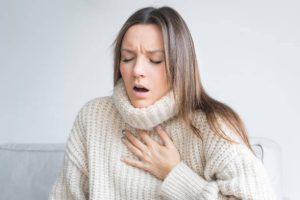ARTICLES
Shortness of Breath When Walking or Climbing Stairs: Causes and Treatments
Shortness of Breath When Walking or Climbing Stairs: Causes and Treatments

Shortness of breath while walking or climbing stairs can be frustrating and sometimes concerning. It may happen occasionally due to exertion, or it could be a sign of an underlying issue. Some people experience this due to lack of physical fitness, while others may have medical conditions that affect breathing.
This article looks at the possible reasons behind shortness of breath and the available treatments.
Causes of Shortness of Breath When Walking or Climbing Stairs
Several factors can make breathing feel more difficult than usual during physical activity. Some are temporary, while others require medical attention.
1. Lack of Physical Fitness
People who do not engage in regular exercise may struggle with shortness of breath when performing activities that require more effort. The body needs to adapt to increased oxygen demand during movement. If someone is not used to physical activity, their breathing may feel labored.
2. Obesity
Excess weight can put extra strain on the heart and lungs, making it harder to breathe during movement. Carrying more weight means the body requires more oxygen, and the lungs may have to work harder to keep up.
3. Anxiety and Stress
Emotional stress and anxiety can cause rapid breathing, also known as hyperventilation. Some people experience breathlessness even when doing simple tasks due to anxiety-related shortness of breath. This can be more noticeable when climbing stairs or walking uphill.
ALSO READ: How to Handle a Partner with Body Odor or Bad Breath Without Hurting Them
4. Asthma
Asthma causes inflammation in the airways, making breathing difficult, especially during exertion. People with asthma may feel breathless even after mild physical activity. Triggers such as dust, cold air, or exercise can worsen symptoms.
5. Chronic Obstructive Pulmonary Disease (COPD)
COPD is a condition that affects airflow in the lungs, making breathing harder over time. People with COPD often experience breathlessness even during light activities. Smoking is a major cause of this condition.
6. Heart Conditions
Heart problems can make it difficult for the body to pump oxygen-rich blood efficiently. Conditions such as heart failure, coronary artery disease, and arrhythmias can cause shortness of breath during physical activity.
ALSO READ: Mental Tricks to Help Him Last Longer in Bed
7. Anemia
Anemia occurs when the body does not have enough red blood cells to carry oxygen to tissues. This can make people feel weak and breathless even during mild exertion. Common causes include iron deficiency, chronic disease, and vitamin deficiencies.
8. Lung Diseases
Conditions like pneumonia, pulmonary fibrosis, and lung infections can lead to breathing difficulties. These issues can reduce lung capacity, making everyday activities harder.
9. Deconditioning After Illness
People recovering from long-term illnesses, surgeries, or extended bed rest may notice shortness of breath when they start moving again. The body takes time to regain strength after periods of inactivity.
10. High Altitude
People who are not accustomed to high-altitude environments may struggle with breathing when walking or climbing stairs. This happens because there is less oxygen in the air at higher elevations.
ALSO READ: 5 Stages of Love in a Relationship: Most Relationships End at Stage 2
Treatments for Shortness of Breath
Treatment depends on the cause of breathlessness. Some cases improve with lifestyle changes, while others require medical intervention.
1. Regular Exercise
Building endurance through regular physical activity can improve breathing efficiency. Low-impact exercises such as walking, swimming, or cycling can help strengthen the lungs and heart over time.
2. Weight Management
Losing excess weight can reduce strain on the heart and lungs, making movement easier. A balanced diet and regular exercise can help with weight control.
3. Breathing Techniques
Practicing controlled breathing can help manage shortness of breath. Diaphragmatic breathing and pursed-lip breathing techniques can improve airflow and reduce discomfort.
4. Anxiety Management
For those experiencing breathlessness due to anxiety, relaxation techniques such as meditation, deep breathing, and cognitive behavioral therapy (CBT) can help. Reducing stress levels can improve overall breathing patterns.
5. Asthma Management
People with asthma should follow their doctor’s advice on using inhalers and avoiding triggers. Regular check-ups ensure that medications remain effective.
6. Treating COPD
COPD treatment includes medications such as bronchodilators, pulmonary rehabilitation, and oxygen therapy in severe cases. Quitting smoking is one of the best ways to slow down disease progression.
7. Managing Heart Conditions
Heart-related breathlessness often requires lifestyle adjustments and medication. In some cases, medical procedures may be needed to improve heart function. Doctors may recommend dietary changes, blood pressure management, and regular exercise.
ALSO READ: How to Walk Away from a Relationship
8. Addressing Anemia
If anemia is the cause, treatment depends on the type. Iron supplements, vitamin B12 injections, or dietary changes can help restore oxygen-carrying capacity in the blood.
9. Treating Lung Infections
Bacterial infections such as pneumonia require antibiotics, while viral infections usually improve with rest and supportive care. Severe cases may need hospitalization.
10. Recovery After Illness
For those regaining strength after illness, gradual physical activity and breathing exercises can help improve endurance. Following a structured rehabilitation plan can speed up recovery.
11. Adjusting to High Altitude
If breathlessness is due to high altitude, the body often adjusts after a few days. Staying hydrated, avoiding overexertion, and breathing slowly can help with adaptation.
When to See a Doctor
While occasional shortness of breath is not always a cause for concern, persistent or severe symptoms should be checked by a doctor. Medical attention is needed if breathlessness comes with:
- Chest pain or tightness
- Wheezing or persistent cough
- Dizziness or fainting
- Swelling in the legs or ankles
- Bluish lips or fingers (a sign of low oxygen levels)
Early diagnosis and treatment can prevent complications and improve quality of life.
ALSO READ: How to Use Breathing Techniques to Help Him Last Longer in Bed
Discover more from 9jaPolyTv
Subscribe to get the latest posts sent to your email.

 POLYTECHNIC NEWS5 hours ago
POLYTECHNIC NEWS5 hours agoFederal Polytechnic Daura Equips Staff with Research Skills at NRF Induction Workshop

 POLYTECHNIC NEWS5 hours ago
POLYTECHNIC NEWS5 hours agoFederal Polytechnic Ado-Ekiti Clarifies NYSC Mobilization for Evening and Part-Time Students

 POLYTECHNIC NEWS4 hours ago
POLYTECHNIC NEWS4 hours agoTragedy in Bauchi: Abubakar Tatari Ali Polytechnic Student Killed in Hostel Robbery Attack

 POLYTECHNIC NEWS4 hours ago
POLYTECHNIC NEWS4 hours agoAnambra Poly Rector Honored at COOU’s 25th Inaugural Lecture Series

 POLYTECHNIC NEWS14 hours ago
POLYTECHNIC NEWS14 hours agoIMT Enugu Departments Go Digital: Council of PROs Launches Social Media Drive to Showcase Campus Excellence

 POLYTECHNIC NEWS5 hours ago
POLYTECHNIC NEWS5 hours agoOYSCATECH Public Administration Marks 10 Years with Drug Donations, Awards, and Cultural Fiesta

 POLYTECHNIC NEWS4 hours ago
POLYTECHNIC NEWS4 hours agoKogi State Polytechnic to Begin Degree Programmes in Partnership with Federal University Lokoja


































